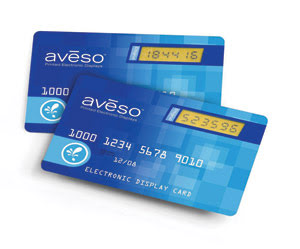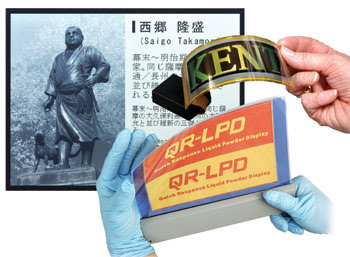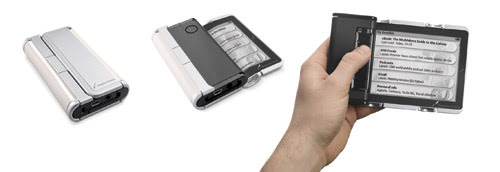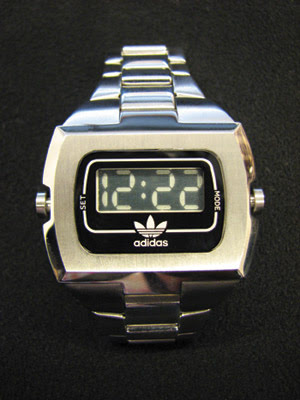A number of technologies and products are vying to be viewed as true electronic paper.
Dr. Paul Drzaic, Unidym Corp.
The growth of flat panel displays over the past decade has been a remarkable story and has enabled the proliferation of flat screens into a number of product categories. Flat panel displays are used primarily in televisions, computer monitors, notebook screens and mobile handsets. What is remarkable is the utter dominance of backlit active-matrix LCD technology in each of these categories.

Electrochromatic displays offer a paperlike look with good viewing angles and reflectivity. Photo courtesy of Aveso Inc.
The combination of constantly decreasing costs and increasing performance in active-matrix LCDs has made it difficult for other technologies, such as CRTs, plasma displays, field emission displays, and organic and passive LCDs, to compete with it in major markets. Active-matrix LCDs either are encroaching in markets previously dominated by these technologies or are preventing new technologies from gaining a foothold. This supremacy is fueled by nearly continuous cost reduction in the fabrication of amorphous silicon backplanes and by improvements in the color, viewing angle and response speed of active-matrix LCDs
Although active-matrix LCD products have gained a strong foothold, they do have shortcomings that limit performance in some application areas:
• Power: More than 90 percent of the power consumption of an active-matrix LCD feeds the backlight, which can consume as much as one-third of the total power of a mobile device. There is strong interest in extending the battery life or reducing the battery size in mobile devices through lower-power displays.
• Sunlight viewing: Most active-matrix LCDs are difficult to read in bright lighting conditions. Transflective displays, which combine reflective and transmissive elements in a single display, extend usage somewhat, but there is increasing interest in “read anywhere” displays.
• Plastic displays/flexibility: Active-matrix LCDs do not lend themselves readily to plastic substrates and flexible formats because the optics of the display are highly sensitive to the cell gap. An interest in thin, flexible and/or large-area devices introduces new form factors and application areas.

The reflective monochrome liquid crystal display on the left was built using a polysilicon active matrix backplane. The display has a low-power memory mode to conserve power for static images. Courtesy of Toshiba Matsushita Display Technology Co. Ltd. in Tokyo. The top right image flexible display is reflective and bistable. It was built using cholesteric liquid crystal technology. Courtesy of Kent Displays Inc. in Ohio. The flexible, bistable, passive matrix display on the bottom right is based on "Quick Response Liquid Powder" air-gap electrophoretic display technology. Courtesy of Bridgestone Inc. in Tokyo.
Several reflective display technologies can address some or all of these shortcomings, so R&D on reflective displays has responded with some interesting technology choices. It is common to hear reflective displays rebranded as “electronic paper” in an attempt to differentiate these products from conventional backlit displays. Numerous technologies are vying to be recognized as the first mainstream application of electronic paper.
Keep in mind that a flat panel display has two major components: the transducer (the electro-optical material that controls light) and the backplane (the electrical addressing grid that controls each pixel within the transducer).
Display backplanes come in many forms — direct-drive (one wire per pixel), passive-matrix (crossed rows and columns) and active-matrix (one or more switching transistors per pixel). A variety of transducers are under development for electronic paper, and technologies such as flexible active-matrix backplanes or printed organic transistors are just as enabling as the transducer in some applications.
Moving pigments
Because a printed image relies on patterned pigments on paper, it is not surprising that some of the most “paperlike” displays rely on pigments also common around print shops. Electrophoretic displays consist of colored pigments suspended in an oil. When a charge is placed on the pigment particles, the particles can be made to respond to an electric field. Pigments such as titanium dioxide and carbon black can be either pulled to the front of the panel or pushed to the back of the panel by the application of a voltage of the right polarity, changing the appearance of a display viewed from the front side.
E Ink Corp. of Cambridge, Mass., has been one of the major developers of electrophoretic display materials, which are then combined with glass- or plastic-based backplanes to make the finished device. Electronic book readers are available from partner companies iRex Technologies of Eindhoven, the Netherlands, and Sony Corp. of Tokyo. E Ink displays also have been fabricated into flexible displays with a number of partners and technologies. Flexible organic transistor backplanes are being developed by Polymer Vision of Eindhoven, the Netherlands, and Plastic Logic Ltd. of Cambridge, UK, while flexible amorphous silicon backplanes are in production from Prime View International Co. Ltd. of Hsinchu, Taiwan, and are in a development stage at LG Philips LCD of Seoul, South Korea. A product under development uses these technologies in a roll-out display for a mobile phone handset (Figure 1).

Figure 1. This roll-out electrophoretic display is designed for mobile phone handsets. Photo courtesy of Polymer Vision.
Other companies are making great strides in electrophoretic displays as well. SiPix Imaging Inc. of Fremont, Calif., has developed a plastic film-based display rugged enough for use within a smart card. In the SiPix technology, a plastic film containing minuscule wells that hold a single colored pigment is dispersed in colored oil, so that the position of the pigment determines whether the viewer sees the pigment or the colored oil. The SiPix displays are then laminated to a backplane — either direct-drive or active-matrix — that addresses the electrophoretic transducer. SiPix direct-drive technology is used in smart card and segmented shelf displays.
Bridgestone Corp. of Tokyo dispenses with the oil entirely, using oppositely charged pigments of two different colors, but in air rather than in oil. This “quick response liquid powder” display has the disadvantage of requiring high-voltage electronics (80 V and up), but it does not need an active-matrix panel for high resolution and can switch in a millisecond time frame. This is used in a passive-matrix (row-and-column electrode) signage product. Bridgestone has developed a flexible film version of the quick response liquid powder display and also has partnered with Hitachi Corp. of Tokyo to launch the Albirey line of color electronic paper displays based on the quick response technology.
Iridescent displays
Two very different display technologies rely on the optical effects of either diffraction or thin-film interference. Cholesteric liquid crystal materials commonly are used as aquarium thermometers or for providing iridescence to beetle shells, but recently these materials have proved capable of making attractive, flexible displays as well. Briefly, the molecules of the fluid cholesteric liquid crystal phase spontaneously form a twisted structure. If the length of this structure is on the order of the wavelength of light, one circular polarization of that light is diffracted back to the source. Choosing the proper twist length through chemical composition enables a cholesteric liquid crystal to reflect blue, green or red light.
To make an electronic display, designers take advantage of the fact that a tidy arrangement of cholesteric liquid crystal molecules will strongly reflect light at its characteristic wavelength, but a jumbled mix of randomly oriented twist domains will reflect light only weakly. The appropriate electronic pulses can change the local arrangement of the molecules within the fluid from one state to the other. Cholesteric displays have the advantage that a simple row-and-column architecture —rather than an active-matrix backplane — can be used to switch the device, and the display shows a memory effect, maintaining an image with zero power.
Several companies are shipping products based on cholesteric displays. Kent Displays Inc. in Ohio has recently demonstrated some remarkably flexible microencapsulated cholesteric films that can beas flexible as cloth, and the company also sells a number of single-color “no color” displays for instrumentation indicators and signs.
Fujitsu Frontech Corp. of Tokyo has developed a line of full-color reflective displays, based on three red, green and blue cholesteric cells stacked on top of each other. Each layer independently modulates its primary color, and the thin plastic cell construction minimizes parallax between images on the different layers.
Magink Display Technologies Ltd. of Mevasseret Zion, Israel, also tiles red, green and blue cholesteric panels to provide full-color images, but these glass-based panels are used to build large displays designed for outdoor operation. This reflective display technology stands up well to direct sunlight (although, like paper, it requires front lighting at night). The display shows not only static images but also video running at up to 50 fps. An example of a tiled electronic billboard is shown in Figure 2.

Figure 2. A billboard uses cholesteric technology.
Another means of building an interference-based display is to use semiconductor processing equipment to build an array of deformable membranes on a glass substrate. This is the approach taken by Qualcomm MEMS Technologies Inc. of San Diego for its interferometric modulator displays. Each pixel consists of a reflective membrane suspended over an absorbing surface. The membrane switches between two states with different cell gaps, forming what is effectively a switchable interferometer. One cell gap reflects a particular visible color (appearing bright), and the other reflects a wavelength outside the visible range (appearing dark).
This technology has many things going for it: high reflectivity, passive addressing, an effective bistability and video-rate operation. Qualcomm has announced that the first interferometric modulator display products will be appearing in a Bluetooth headset.
Reflective liquid crystals
Although polarizer-based liquid crystals are dominant in mainstream displays, there also are several initiatives to develop variants of this technology for electronic paper applications. LCDs based on conventional manufacturing processes have a major implementation advantage over more novel technologies in that there already exists an infrastructure to build LCDs. Surprisingly, even though these displays include a light-robbing polarizer, several attractive reflective monochrome displays have been developed.
ZBD Ltd. of Windsor, UK, incorporates a grating into one surface of the liquid crystal cell. Instead of serving an optical function, the grating imparts the ability to switch the cell between two stable states. In a single polarizer reflective mode, an attractive low-power display can be built for a shelf label in retail store applications (Figure 3).

Figure 3. Shelf-label displays use passive-matrix technology in a single polarizer reflective mode. Photo courtesy of ZBD Ltd.
Another variation on the passively addressed bistable liquid crystal cell is from Nemoptic of Magny les Hameaux, France. Using a special surface treatment, a thin cell and special addressing waveforms, the company’s BiNem technology can be used to build electronic paper displays without the need for an active matrix. Applications for this technology include shelf labels and electronic book readers.
Toshiba-Matsushita Display Technology Co. Ltd. of Ishikawa, Japan, has taken the approach of building its electronic paper innovation into the backplane, rather than inventing a new transducer. The company uses a low-temperature polysilicon backplane with memory elements incorporated into each pixel, providing normal LCD operation when fast updating is needed, and enabling a low-power memory mode when the display is not being updated. Careful attention to optics also has produced an LCD with good reflectivity.
Electrowetting technology is the focus of Liquavista BV of Eindhoven, the Netherlands, a spinoff of Philips Electronics Research Laboratories, also based in Eindhoven. Each pixel in a Liquavista display consists of a small cell filled with a combination of colored oil and clear water. The oil typically covers the cell (making it colored), but application of a voltage causes the water to displace the oil from the viewing area, revealing a reflector underneath the cell.
The potential of the technology to achieve multiple colors and to switch at video rates makes this technology highly promising. The company announced that its first product offering will be a series of simple segmented displays for applications such as watches (Figure 4). Here, high reflectivity and the ability to tailor the dye to match exact colors are the drawing points for the display. The company also demonstrated compatibility with an active-matrix backplane, producing a color video-rate display prototype.

Figure 4. Using electrowetting technology, as shown in this watch, a small cell is filled with a combination of colored oil and water, enabling exact color matching. Photo courtesy of Liquavista BV.
Electronic dyes
Many everyday objects obtain their colors from dyes that are permanently embedded within the object. Electrochromic displays are based on the fact that, by injecting an electron or hole into the dye, some dyes can be switched between a colored and colorless state, changing both its charge and its electronic structure. Unlike other approaches that respond to an applied voltage, electrochromic displays are current-based and need the passage of current through the cell to change color. Most electrochromic displays contain an active dye element that switches between a dark absorbing state and a transparent state that reveals a bright reflective surface beneath the cell.
Advantages of electrochromic displays include a paperlike look with good viewing angles and reflectivity. Compatibility with flexible packages and simple low-cost manufacturing practices also are attractive. Several companies have announced development of electrochromic displays: examples and some applications include displays for smart cards from Aveso Inc. of Fridley, Minn., which is initially aiming at low-cost, durable displays for smart cards. Other major participants include Ntera Inc. of Dublin, Ireland, which produces fast switching, flexible and large-area displays for signs and indicators, and Siemens AG of Munich, Germany, which has low-cost displays for active packaging.
Outlook
It is apparent that there is no shortage of technologies vying to become the electronic paper of the future. Rather than taking on active-matrix LCDs in their major markets, these new technologies are aiming at niches where active-matrix LCDs cannot go readily. Electronic shelf labels, electronic books, electronic billboards and flexible displays are all emerging areas that are working to gain market acceptance.
This is a competitive and risky area where possibly more than one technology can address a given product category. Moreover, it is not clear which product categories show the best short-term promise for growth. What is nearly certain, however, is that the companies that choose the correct initial applications and that can manufacture reasonably priced products to meet customer needs will gain the foothold necessary to challenge bigger markets down the road in much the same way that active-matrix LCD technology today is displacing CRT technology as the dominant electronic display.
Meet the author
Paul Drzaic is chief technology officer at Unidym Corp. in Menlo Park, Calif., and is president-elect of the Society for Information Display in San Jose, Calif.; e-mail: [email protected].